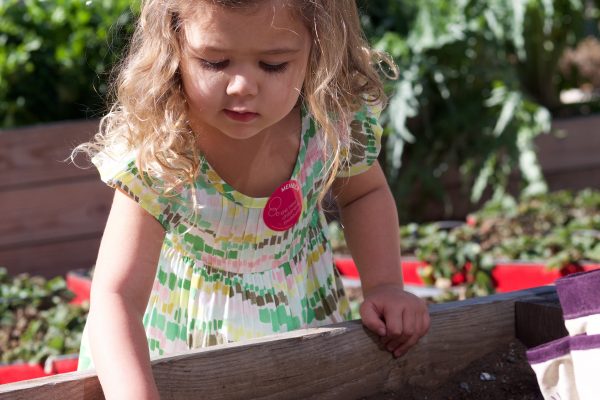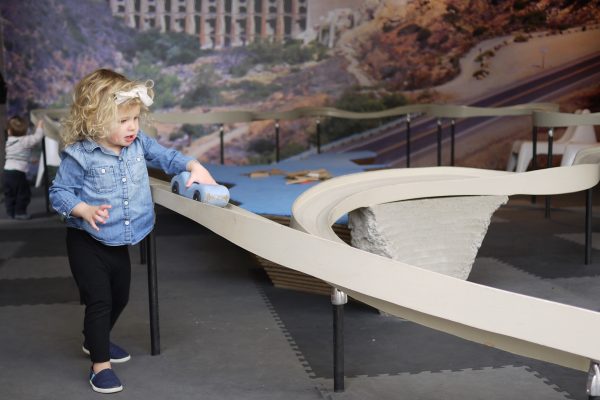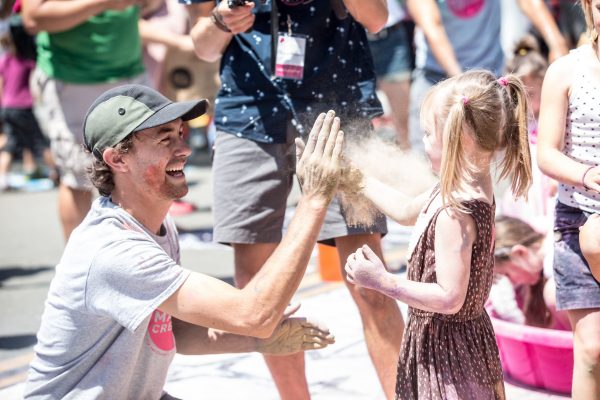do it yourself: cereal box guitar
Get ready to rock! Create an artistic guitar made from items found at home. Assemble the working instrument and sculpture using an empty cereal box, paper towel tube and more. Kids can make it their own and then play it for family and friends!
guidelines + materials
AGE: 4+ (with adult support)
TIME FRAME: 30 – 40 minutes
SUPPLIES:
- Cereal Box (any size; a large cracker or yogurt box also works)
- Paper Towel Tube
- 4 Rubber Bands (different colors if available)
- Roll of Tape (2-inch packing tape or masking tape)
- Pencil, Piece of Chalk or Marker
- Scissors or X-Acto knife (cutting done by adult or with their support)
- Tempera or Acrylic Paints and Brush (markers or Sharpies can be used instead)
- Plastic Cup or Large Tape Roll
- Yarn or String
- Stickers (optional)
directions
1. Color the guitar body. Take the empty cereal box and paints, markers or colored pens and add color. With the paint, the design of the cereal box will shine through. If you do not like this look, you can first cover the box with a thick white paint (acrylic) or gesso. You can also cover your box with paper. To help the painted box dry faster, place it outside in the sun.
2. Cut out the sound and neck holes. Once fully dry, get ready to cut two holes in the box for the sound hole (center hole in guitar) and the hole for the neck (guitar handle). On the front side of the box, take a large tape roll or large plastic cup, and trace the circle shape onto the box using pencil, chalk or marker. Make sure to place the sound hole slightly below the center of the box, so that the neck does not show through the hole. To cut the sound hole, use an X-Acto knife (with adult support and supervision) or take a large pair of scissors to puncture a hole in the center of the circle and then cut up to the circle line and all around it. For the neck hole, be sure to seal any open flaps on the box using tape. Use the paper towel tube (neck) to trace a circle on the top of the box and cut it.
3. Attach the guitar neck. Take the paper towel tube and push it through the hole on the top of the box. Push the tube down to the point where it is just above the sound hole. Using a 4-inch piece of packing or masking tape, place one part of the tape on the top of the box (just above the sound hole) and then wrap it under and onto the paper towel tube. This should help to hold the tube (neck) in place. Adjust all parts as needed.
4. Add the strings. Place all four rubber bands (one at a time) around the cereal box (guitar body) and over the sound hole. Space the rubber bands on either side of the paper towel tube, about an inch apart from each other and across the sound hole. Strut the strings and notice the sounds they make. If you are working with rubber bands of different widths (thinner and thicker), notice the different sounds they each make.
5. Embellish your guitar! Make your cereal box guitar uniquely yours. Using stickers and/or drawing materials, add designs to the guitar. Using a fairly thin piece of yarn or string, create a guitar strap. Tie one end of the string onto the top of the guitar neck. Then, place the guitar in front of you, as if you’re playing the instrument. Measure the strap for yourself by pulling the string around your body and tying the other end onto one of the center rubber band strings at the bottom of the guitar. Before securing the string, make sure that your guitar is hanging just below the waist.
6. Rock out! Once you’ve made your guitar, you now get to play it! Consider designing other instruments from items around the house – e.g. make a drum set. Compose a song yourself, or invite your family to play with you and form a band.
Additional Learning Activities (Grades PK – 3)
Explore the design and parts of a guitar
How is a guitar designed? If you have a real guitar at home, look closely at it together, or view images of a guitar online or in a book, and notice the many elements of its design. What missing parts of a guitar can your child add to theirs?
Learn about famous guitarists and listen to their music
With your child, take the opportunity to listen to the sounds a guitar makes and to enjoy the ways that musicians throughout history, various cultures and musical genres have used it in their music. Ask family members if they have favorite guitarists and to share their music with you. Encourage your child to decide what they like and to think about why.
Learn about the history of the guitar
The guitar has been around since the 16th century and undergone a lot of changes. Research together the guitar’s history and find pictures of it over time. What changes can you talk about together?
CA State Standards
CA Arts Standards for Visual Arts (PK – 3):
- Engage in self-directed or collaborative exploration with a variety of arts materials.
- Engage in exploration and imaginative play with various arts materials.
- Use observation and investigation in preparation for making a work of art.
- Repurpose found objects to make a new artwork or design.
- Apply knowledge of available resources, tools and technologies to investigate personal ideas through the art-making process.
CA Arts Standards for Music (PK – 1):
- With substantial guidance, explore and experience a variety of music.
- With guidance, demonstrate and choose favorite musical ideas.
- With limited guidance, create musical ideas (such as answering a musical question) for a specific purpose.



